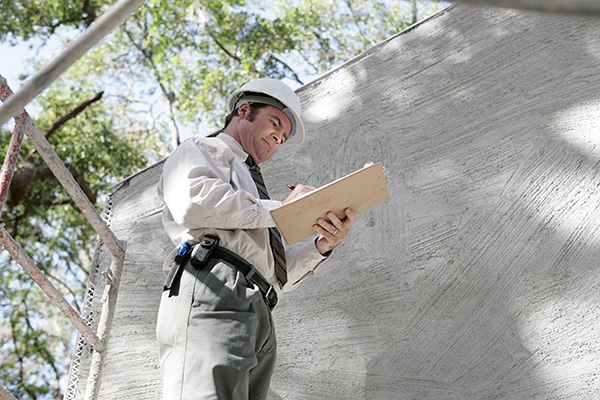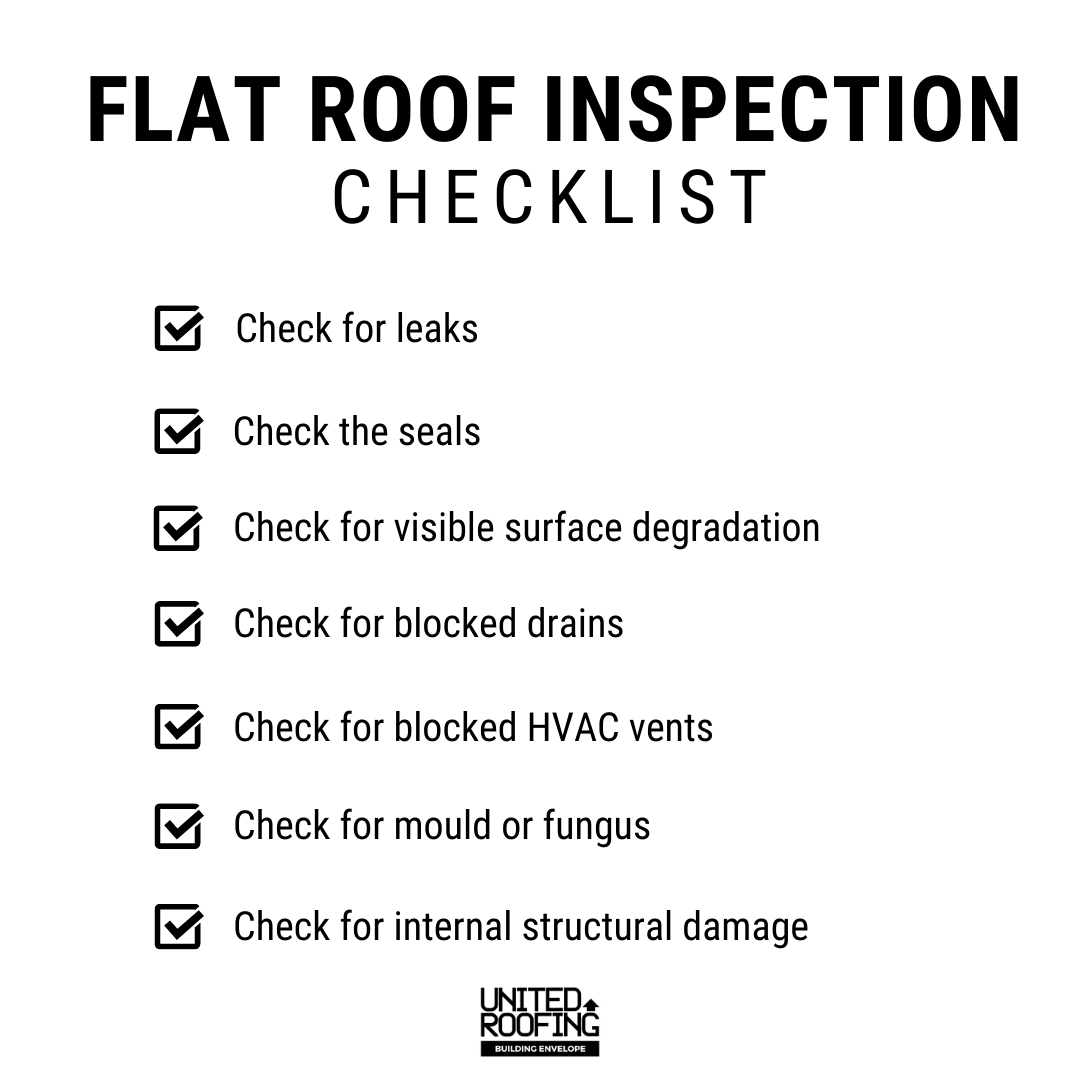Flat Roof Inspection
 A high-quality flat roof can last up to 40 or 50 years. But yours could last half that time unless you maintain it properly.
A high-quality flat roof can last up to 40 or 50 years. But yours could last half that time unless you maintain it properly.
For many businesses here in Calgary and Edmonton, a flat roof is the first line of defence against severe weather conditions. It needs to be maintained to prevent problems from arising.
Planning regular flat roof inspections will help protect your business, extend the roof’s life, and prevent minor issues from becoming crises.
But what will your roofing contractor be on the lookout for when inspecting your roof?
Here are 7 of the most important checks to include on your flat roof inspection checklist – with a handy downloadable checklist.
Why is it important to inspect a flat roof regularly?
Commercial buildings may house employees and tenants, as well as products, equipment, materials, and so on.
Protecting these assets should be fundamental for any business owner and a regular roof inspection helps you do that.
With the heavy snow, icy winds, hail storms, rain, and strong sun here in Alberta, neglecting your roof is a huge mistake. Small imperfections can quickly lead to major safety issues for employees, spoiled products, water damage to your building, and a host of other problems.
Regular surveying of your roof for problems helps prevent this and provides the peace of mind that your roof is in good shape.
How often should you inspect your roof?
It is advisable to plan for at least one professional inspection of your flat roof per year.
If you want to conduct a visual inspection of your own from time-to-time as a preventative measure too, make sure that it is safe to do so.
It’s best to carry out the professional inspection in the fall before the extreme winter weather arrives here in Calgary and Edmonton.
Winter is the time when leaking or drafty roofs tend to cause the biggest problems and minor flaws can easily turn into major problems.
Does the type of roofing material affect the need for an inspection?
Your inspection may vary slightly depending on the type of roofing material used. Flat roofs in Calgary and Edmonton are commonly constructed from the following:
- Built-up roofing material (BUR)
- EPDM, TPO or SBS membrane
- PVC
- Modified bitumen
Metal
There are performance variations between these materials (and different life expectancies) but our inspection checklist focuses mainly on the common checks performed on all flat roofs.
REQUEST A CONSULTATION
7 important checks to include on your flat roof inspection checklist
A professional roofing inspection will provide a detailed review of the condition of your roof. Seven of the most fundamental checks for any commercial flat roof are:
Check For Leaks
You probably guessed this one!
Leaks are a fundamental flaw of any roof. However, it’s not just major leaks that need to be plugged.
With flat roofs, water often has difficulty running off and may “pool” on the surface.
After storms and in exceptionally wet periods of weather, standing water leads to “ponds” that can exert pressure on the roofing material, often causing small leaks to develop. If these are left unattended, they can develop into major issues.
This problem applies to all synthetic and traditional flat roofs. On metal flat roofs, rusting can exacerbate the problem
Check The Seals
Sealants are often used on synthetic membranes and cement-based flat roofs to create a waterproof roofing system.
This helps to prevent water on the base flashing and reglets but cracked or otherwise-deteriorated sealant is a leak threat.
Caulking or tar can also lose their effectiveness. Check all structural openings, including plumbing collars, the corners of penetrative vents, and coping joints.
Check for visible surface degradation
Apart from the climactic challenges here in Alberta, flat roofs may be subject to heavy foot traffic and pressures from weighty rooftop equipment like HVAC vents.
This can all contribute to roof degradation.
An inspection needs to check for tell-tale signs of degradation, such as holes, small punctures or tears, blistering, granular loss, rotting, rust and so on, depending on the roofing material.
Check for blocked drains
Loose debris such as leaves, roofing material, animal waste, or other materials on the roof can be carried to the drains in heavy rain.
This can lead to drain blockage, which may deepen any issues with water pooling on the flat roof surface.
A professional inspection can use snake cameras to check drains for blockages.
Check for blocked HVAC vents
You also need to check HVAC vents for blockages as the high temperatures this causes can start to degrade roofing, even melting certain materials – not to mention the damage to the HVAC system.
The ensuing problems caused by blocked vents can lead to possible leaks, so it’s important to inspect all vents regularly and clean them, if necessary.
Check for mould or fungus
Mould, fungus, moss or algae is an unwanted intruder on your flat roof because it indicates the permanent presence of moisture.
Remember, these intruders are alive and growing. They can weaken roofing membranes, wooden structures, and even be detrimental to the foundations of the roof.
To avoid damage to your roof and an unhealthy presence for building occupants, make sure that checking for living matter is on your roof inspection checklist.
Check for internal structural damage
Surface degradation (see above) may be relatively easy to spot. However, structural degradation usually requires a well-trained eye.
Typical problems include damaged joists (from the weight of roofing material), mould or mildew on joists, and cracked sealants on reglets.
Serious structural damage may require urgent action so this must be ruled out in any inspection.
However, subtle signs of damage also need to be taken seriously before they lead to larger issues and compromise safety.
Self-inspection vs. professional inspection
Some of the checks included in our flat roof inspection checklist could potentially be carried out as DIY by an untrained individual.
Indeed, regular checks of the roof from the ground are recommended (you can use binoculars).
However, before anyone scales a ladder or starts checking a roof at height, consider the safety aspect first and foremost.
Putting the safety of employees at risk should not be an option for business owners. Requesting visual roofing inspections may endanger your people.
Besides, the majority of flat roofs protect important business assets and so cutting corners can lead to expensive problems.
A professional roofing inspection from an established roofing company will be more thorough and safer and will identify potential problems in the immediate future with your roof.
The inspection team will have access to specialist inspection equipment to assess the condition of your roof far more accurately than the naked eye.
The age of your roof is important – problems are more likely with older or poorly installed roofs, especially after adverse weather conditions. A professional inspection team will be experienced in looking for the tell-tale signs of damage for your specific roofing material relevant to its age and the recent weather conditions.
This can prevent problems from becoming expensive disasters.
Get ready for winter with a flat roof inspection
To maintain your roof in tip-top condition, United Roofing Inc. can perform your flat roof inspection in Calgary or Edmonton.
Whether you run a retail or industrial building, office tower or apartment building, a maintenance professional will visit your premises and inspect your roof.
We will provide a report outlining any issues we identify and a quotation if preventative maintenance is required.
Remember, inspections save you money in the long run.

